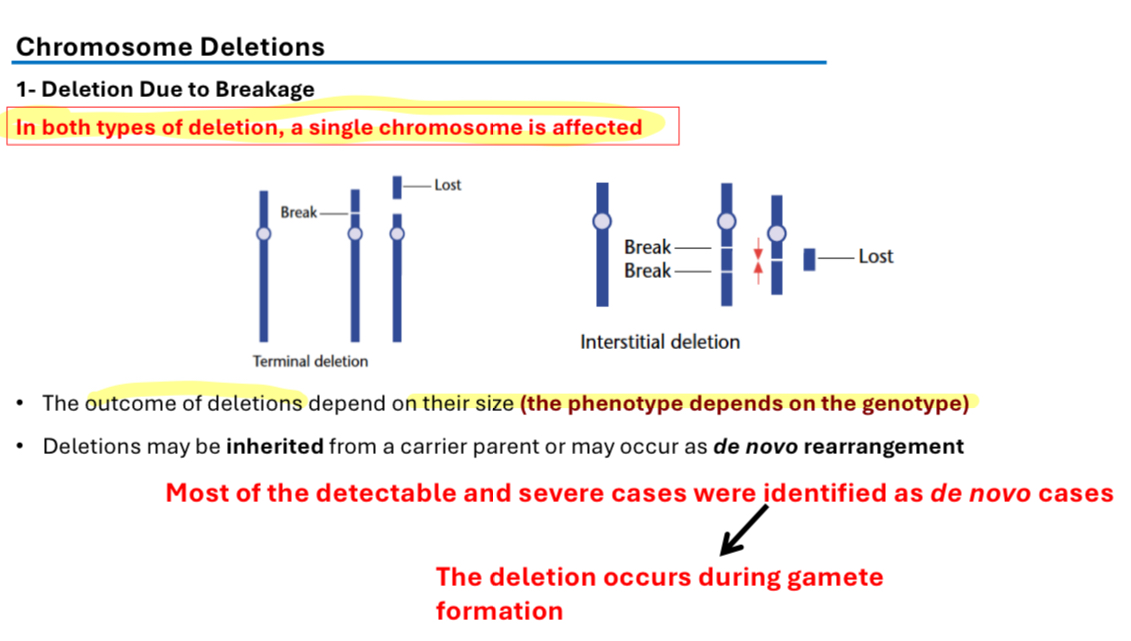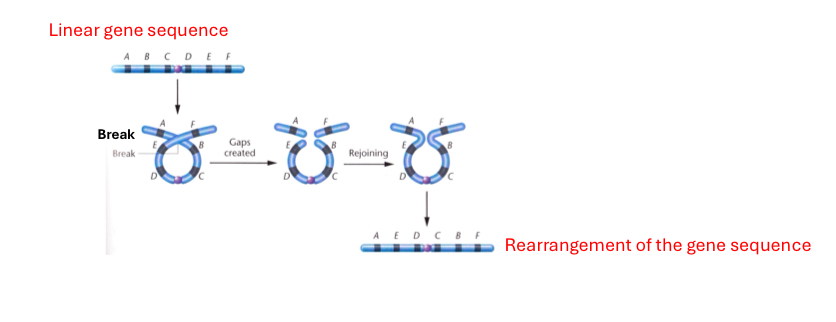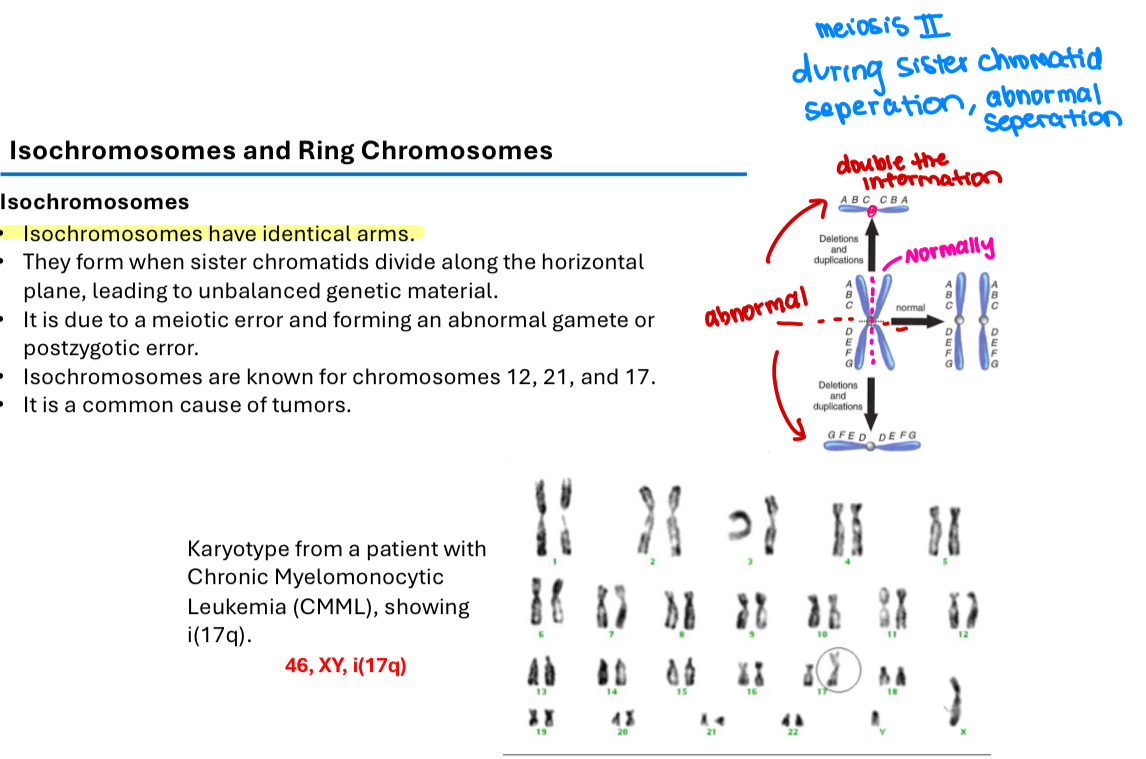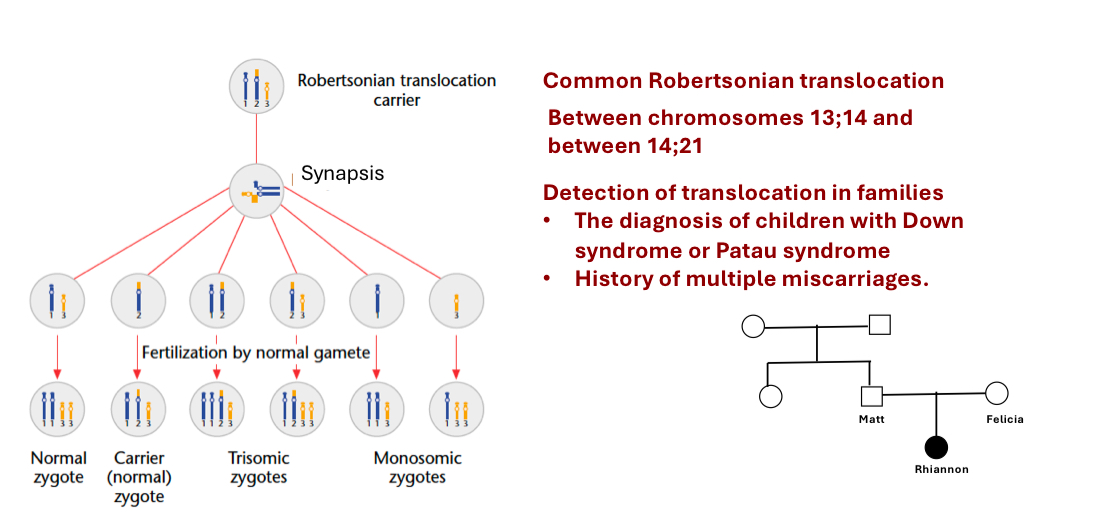Cytogenetics 10/28 & 10/30: Structural Chromosome Abnormalities & Chromosomal Disorders
1/24
Earn XP
Description and Tags
These flashcards cover key vocabulary terms related to cytogenetics, focusing on structural chromosome abnormalities and chromosomal disorders.
Name | Mastery | Learn | Test | Matching | Spaced |
|---|
No study sessions yet.
25 Terms
Chromosome Deletion, 2 causes and 3 examples of syndromes causes by chromosome deletions
A chromosomal abnormality in which a portion of chromatin from a single chromosome is lost.
A deletion occurs when a chromosome loses a segment because of a breakage
It occurs due to unequal crossing over
Deletions may be inherited from a carrier parent or may occur as de novo rearrangement
Most of the detectable and severe cases were identified as de novo cases. The deletion occurs during gamete formation
Examples of chromosomal deletions
Cri-du-chat syndrome: 46, XX(XY), del(5p) (pter)
DiGeorge syndrome: 46, XY(XX), del(22((q11)
Prader-Willi syndrome and Angelman syndrome, both deletions of chromosome 15 long-arm.
When the deletion is inherited from the father - Prader-Willi (PWS) syndrome
When the same deletion is inherited from mother - Angelman syndrome

Translocation and the 2 types
An example of a structural chromosome abnormality - the movement of a chromosomal segment to a new location in the genome.
involves two non-homologous chromosomes in which an exchange of chromosomal material between the two non-homologous chromosomes occurs.
Balanced translocations are very common
Two types of translocations
Reciprocal translocation
Robertsonian translocation
46,XX,del(5p)(pter)
46,XY,del(5p)(pter)
Cri-du-chat syndrome
A deletion at the terminal part of the short arm of chromosome 5, leading to severe mental retardation and specific facial defects.
46,XX,del(22(q11))
46,XY,del(22(q11))
DiGeorge Syndrome
Results from a chromosomal deletion in chromosome 22, causing craniofacial anomalies and heart defects.
Inversion and the 2 types
Chromosome structural abnormality: inversions
Intra-chromosomal structural rearrangement where the genetic segment is turned around 180 degrees within a chromosome.
Inversions do not involve a loss of genetic information but involve the rearrangement of the linear gene sequence
An inversion requires two breaks along the length of the chromosome and subsequent reinsertion of the inverted segment
The size of the inverted segment may be short or long, and the inverted segment may or may not include the centromere
Paracentric inversion: the 2 breaks are in one arm, doesn’t include the centromere
Pericentric inversion: the 2 breaks spanned the 2 arms and it includes the centromere
Inversions can be de novo, or passed from parents to offspring.
Carrier will have reproductive problems, can be traced to meiosis

Isochromosome and the 3 common-known chromosomes affected
A chromosome with identical arms caused by misdivision of sister chromatids. Due to meiotic error and forming an abnormal gamete or postzygotic error. Leading to unbalanced genetic material
Isochromosomes are known for chromosomes 12, 21 and 17
It is a common cause of tumors

Ring Chromosome
Chromosomes shaped like rings that may arise when telomeres are lost and leave sticky ends that adhere together, leading to gene disruption.
Ring chromosome 20 causes seizures

Mosaicism
The presence of two or more genetically different cell lines in the same individual.
Starts with a single fertilized egg, that develops errors in cell division during development. The earlier in development the error, the more severe the outcome.
Examples
Mosaic Down syndrome
Mosaic Klinefelter syndrome
Mosaic tuner syndrome
Robertsonian Translocation
Robertsonian translocations are unique types of whole-arm translocations.
two acrocentric (long arms fuse, loses short stubby arms) chromosomes fuse at the centromere, causing a REDUCTION in the chromosome number to 45, but usually do not cause phenotypic effects
This can lead to aneuploidy or balanced carriers.
Carrier individuals will not generally show any physical phenotypic effects until reproduction example translocation:
Down syndrome
Patau syndrome
Common Robertsonian translocation between chromosomes 13;14, and between 14;21

Balanced Translocation
A chromosomal rearrangement that preserves the total amount of genetic material.
Gametes
Reproductive cells that carry half the genetic material required to form a new organism.
Non-disjunction
The failure of chromosomes to separate properly during cell division, leading to aneuploidy.
Trisomy
examples of autosomal trisomy and sex chromosomal trisomy
a type of Numeric abnormality, aneuploidy. A condition where an individual has an extra copy of a chromosome, leading to genetic disorders. (2n+1)
Autosomal trisomy:
Edward’s Syndrome (47, XY, +18)
Down Syndrome (47, XY, +21)
Patau’s Syndrome (47, XX, +13)
Sex chromosome trisomy:
Trisomy X (47, XXX)
Klinefelter Syndrome (47, XXY)
Jacob’s Syndome (47, XYY)
Monosomy
A type of numeric abnormality, aneuploidy. A condition where an individual is missing one copy of a chromosome. (2n-1)
Autosomal: LETHAL ☠
rare cases individuals survive usually occur in cases of Partial monosomy (only a part of the chromosome is missing) OR mosaicism (where some cells are missing the chromosome, some cells have the chromosome)
Sex chromosome: Turner Syndrome (45,X) (2n-1)
Haploinsufficiency
A dosage effect of chromosome abnormalities.
The phenomenon where a single functional copy of a gene is insufficient to maintain a normal phenotype. Occurs when one copy of a gene is inactivated or deleted.
Dosage = 1, one copy deletion.
Cytogenetics
The branch of genetics that studies the structure and function of the cell, especially the chromosomes.
Mitosis
The process of cell division that results in two genetically identical daughter cells.
Meiosis
The process of cell division that reduces the chromosome number by half, resulting in gametes.
2 outcomes of unequal crossing over
Balanced: chromosomal rearrangement with the correct amount of genetic material in a cell. Genetic material is in a different chromosomal arrangement, but it is in the correct amount and functioning properly, and often does not produce serious health consequences.
Unequal: Chromosomal rearrangement with a
deletion and/or
duplication of genetic material. Deletion due to unequal crossing over between misaligned homologous chromosomes
Examples
Thalassemias - a group of inherited hemoglobin disorders and the most common human single-gene disorder
Thalassemias
Thalassemias are inherited blood disorders that result in reduced or absent production of either alpha or beta globin chains, causing varying degrees of anemia and related health issues.
The most common human single-gene disorders
Normally, equal amounts of alpha and beta globin chains are produced to make hb molecules with two alpha chains and two beta chains.
Genetic mutations that affect the production of the globin chains can lead to imbalance in the ration of the alpha-beta chains causing this inherited chronic anemia, thalassemia
Alpha-thalassemia - reduced number of alpha chain and increased number of beta-chain
Reciprocal translocation
Happens when breaks occur in two different chromosomes and the material is mutually exchanged
The total chromosome number is unchanged (46)
No genetic information is gained or lost in the exchange, but genes are moved to new chromosomal locations
The resulting chromosomes are called derivative
Carrier individuals will not generally show any physical phenotypic effects
Carriers may show reproductive abnormalities, infertility, spontaneous abortions and abnormal offspring

Chromosome abnormalities - the 4 Structural abnormalities and their subgroups
Deletion
Breakage
Unequal crossover
Balanced
Unequal=deletion/duplication
Duplication
Unequal crossover
Inversion
Paracentric
Pericentric
Translocation
Recipricol
Robertsonian
2 types of chromosomal deletions due to Breakage
Terminal deletion
Interstitial deletion
The outcome of deletions depend on their size (the phenotype depends on the genotype)
Deletions may be inherited from a carrier parent or may occur as de novo rearrangement. Most of the detectable and severe cases were identified as de novo cases. The deletion occurs during gamete formation.
Examples of chromosomal deletions
Cri-du-chat syndrome, 46, XX, del(5p) (pter) or 46, XY, del(5p) (pter)
DiGeorge Sydrome 46, XY, del(22((q11) or 46,XX,del(22((q11)
Prayer-Willi Syndrome (PWS inherited deletion from father) and Angelman Syndrome (inherited deletion from mother); both conditions result from chromosome 15 long arm deletion.
Alpha Thalassemia
A genetic blood disorder characterized by reduced production of hemoglobin due to deletions or mutations affecting the alpha-globin gene cluster on chromosome 16. This can lead to anemia and other related health issues.
Normal - 4 functional genes
a-thalassemia trait; 2 functional a-genes, homozygous or heterozygous
HbH disease - 1 functional a-gene
Hb Bart’s Hydrops Fetalis Syngdrome - Lethal, 0 functional a-genes
2 Translocation types
translocation is a type of structural abnormality.
Reciprocal translocation: (46,XY, t(3;6) (p13;p22)) happens when breaks occur in two different chromosomes and the material is mutually exchanged. Total chromosome number is unchanged (46). No genetic information gained/lost. The resulting chromosomes are called derivative. No physical phenotype but spontaneous abortions and abnormal offspring.
Robertsonian Translocation: (45,XX, t(14q;21q)) are unique types of whole-arm translocations. Involves any two acrocentric chromosomes and results from the centric fusion of the long arms of these two chromosomes. Reduction in the number of chromosomes by 1, loss of the short arms. Generally no phenotype but abnormal reproduction.